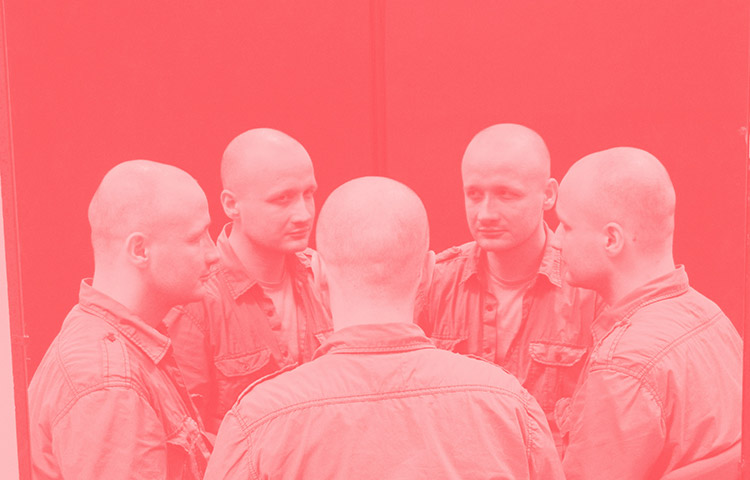
Paweł Janicki is a new media artist, author of music performance works, and producer. He was born in 1974 and lives and works in Wrocław.
Janicki is a founding member of the music group Gameboyzz Orchestra Project, which plays music on GameBoy consoles. He collaborates with the WRO Art Center, where he manages the WRO Lab, as well as with the Youth Behind the Machines Group, Nemesis, Job Karma, the 25fps Group, and Samploza Lab Anssample. He has taken part in numerous festivals and exhibitions related to experimental music, visual arts, and new media art. In 2004, he received an award from Tokyo University Haramachida for his internet performance Ping Melody.
Paweł Janicki’s activities are extremely difficult to classify. He engages in generative music and microsounds, but his compositions occasionally also take the form of visual pieces (for instance, fractal animations). He creates compositions based on algorithms and interactive systems, as well as installations and performances. He draws inspiration from the electronic and electroacoustic avant-garde. He uses self-designed programs and military or commercial technology.
The audiovisual performance works presented under the title Ping Melody have become Janicki’s trademark. The music generated in the course of their duration may be influenced by random internet users. The sound of an instrument or a singer’s voice can be transformed into a data package, which is then transmitted to various online locations and returns in a modified form due to glitches and latencies. For instance, during one of the Ping Melody performances, a sound played by the classical musician Jan Kopták (flute and saxophone) was bounced off the servers of the U.S. Army (2007). The audio layer was accompanied by an image – a visualisation of the flow of information and error notifications.
He also used online networking in the installation Net Eater. Data “netted” from the web was transformed into diverse audiovisual forms. The artist was not interested in semantic correlations, but only in translating the flow of information into an abstract form.
In 2010, Janicki created the interactive installation Mapping Chopin, presented at the Warsaw Autumn festival in Warsaw and at the Dilston Grove Gallery in London. Its system identified visitors’ movements and converted them into the vertical and horizontal axes of a score. In this way, the audience members influenced the dynamics, tempo, or the articulation of the selected compositions by Fryderyk Chopin (Étude in A-flat major Op. 25, No. 1, Waltz in A minor, Op. 34 No. 2, Tarantelle in A-flat major, Op. 43, and Nocturne in G minor, Op. 15, No. 3), as well as the visual representation of the score in space.
Another interactive installation by Janicki was Oceanus (presented at the European Media Art Festival in Osnabrück, Germany in 2011), which was based on the idea of maritime navigation, transferred to the new media environment. A large-format, horizontal touch screen allowed several viewers at a time to, for instance, manipulate the objects, and enabled interaction between them. The results of the process emerging on the horizontal screen were projected on another screen placed vertically.
Janicki also co-created the Interactive Platform (together with Dominika Sobolewska and Patrycja Mastej) at WRO Art Center. The project was later presented at a number of contemporary art galleries in Poland, such as Zachęta National Gallery of Art in Warsaw and Centre of Contemporary Art Znaki Czasu in Toruń. The installation engages the youngest audience members, resembles a laboratory, invites experimentation, and is most of all based on the notion that exhibits can, or even should be, touched. Many of them introduced contemporary technology and interactivity.
In the second half of 2011, on commission from the Adam Mickiewicz Institute, Janicki created the project EU Tracer, coinciding with the celebrations of the Polish presidency of the Council of the European Union. It was a performance in public space, taking place in selected capitals of the EU member countries. A specially created programme produced musical and visual structures sourced from transformed data downloaded from servers of the European Community organizations. The thus created pieces were accompanied by improvisations performed by a guest musician.
http://culture.pl/en/artist/pawel-janicki
http://paweljanicki.jp/
Paweł Janicki,新媒体艺术家,音乐家兼制作人。出生于1974年,现定居工作于华沙。
Janicki是为GameBoy游戏机提供配乐的音乐团体Gameboyzz Orchestra Project的创办成员之一。 他长期与WRO艺术中心(WRO Art Center,并由他主管WRO实验室)以及Youth Behind the Machines Group、Nemesis、Job Karma、the 25fps Group, Samploza Lab Anssample等进行合作。Janicki曾参与众多与实验音乐、视觉艺术和新媒体艺术相关的艺术节和展览。2004年,他因线上表演作品Ping Melody获得由Tokyo University Haramachida颁发的奖项。
给Paweł Janicki的艺术行为下定义是极其困难的。他参与衍生音乐和微声电子乐的创作,但是他在作曲中有时也采用视觉元素形式(例如分形动画)。他在演算法和交互系统的基础上进行音乐创作、装置和表演。Janicki的灵感来源于电子乐与前卫电声。 他通常使用个人设计的程序和军用或商用科技。
在Ping Melody名义下推出的视听表演作品已经成为Janicki的个人标志。音乐的创作过程中可能受到某些随机的网络用户的影响。某件乐器的声响或者某位歌手的声音可能会被转化为数据包传送到不同的网络地址,并在网络小故障或延迟等原因的影响下被加以修饰后传送回来。例如,2007年,在某场Ping Melody的演出中,古典音乐家Jan Kopták用长笛和萨克斯演奏的声响从美国军方服务器传回。其音轨中夹带一张图片——信息流的可视化图片和报错提醒。
他同样在装置Net Eater中使用在线网络来实现作品。从万维网上“网罗”来的数据被转换成多样的视听形式。艺术家并不关注信息在语意上的关联,仅仅是将信息流转化成某种抽象形式。
2010年,Janicki创作了交互装置Mapping Chopin,并在华沙秋季音乐节(Warsaw Autumn Festival)和位于伦敦的迪尔斯顿格罗夫画廊 (Dilston Grove Gallery)进行了展示。该装置的系统识别观众的动作行为并将这些动作转化为二维坐标系上的数值。由此,观众们也影响着肖邦精选曲目(Étude in A-flat major Op. 25, No. 1, Waltz in A minor, Op. 34 No. 2, Tarantelle in A-flat major, Op. 43, and Nocturne in G minor, Op. 15, No. 3)的力度变化,节拍,发声和空间视觉化展示变动。
2011年,Janicki的另一个交互装置海神(Oceanus)在德国奥斯纳布吕克的欧洲媒体艺术节 (European Media Art Festival)上展出。该装置将海上导航方面的想法用于新媒体环境中。 一个水平放置的大幅面触控屏幕可让多个用户同时操作,例如通过操控物体等以实现彼此互动。 这些在水平屏幕上的操作结果被投射在另一块垂直放置的屏幕上。
Janicki与Dominika Sobolewska和Patrycja Mastej一起在 WRO艺术中心创造了交互平台( Interactive Platform)。该项目随后在波兰的多个当代艺术馆进行展出,例如位于华沙的Zachęta国家艺术画廊(Zachęta National Gallery of Art) 和位于托伦的当代艺术中心(Centre of Contemporary Art Znaki Czasu)。该装置非常吸引年轻的观众,类似于一个实验室,让他们参与实验。大多数基于概念的展示可以或者说应该被触摸。它们诠释了当代技术和交互性。
在2011年下半年,为了庆祝波兰成为欧盟理事会(Council of the European Union)轮值主席国,在密茨凯维奇学院 (Adam Mickiewicz Institute) 的委托下,Janicki发起了项目EU Tracer。 该项目是在某些特定欧盟成员国首都的公共空间进行表演。他特意开发了一个程序用来处理由欧盟服务器下载数据转换而来的音乐与视觉结构源。这些创作的片段被用于客邀音乐家的即兴表演伴奏。